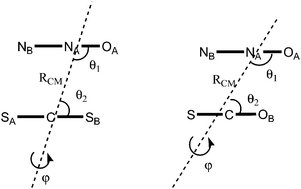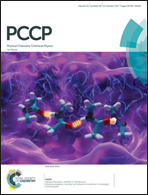Bonding and spectroscopic analyses of N2O–CS2 and N2O–OCS heterodimer complexes and their atmospheric consequences†
Abstract
Different isomers of the valence isoelectronic pairs of the heterodimers N2O–SCS and N2O–OCS were investigated using MP2 and CCSD(T) methods with the aug-cc-pVXZ (X = D, T) basis set with anharmonic frequency calculations. Interaction energies of both the heterodimers were estimated at the CBS limit and for CCSD(T)/aug-cc-pVTZ. One isomer was located for the N2O–SCS heterodimer. In the case of the N2O–OCS heterodimer, three planar slipped-parallel isomers were characterized. There was no significant change in electron density at the bond critical points (BCPs) of various intra-bonds but the presence of inter-bonds with a weak electron density at the BCPs in the complexes was found as per the results from the quantum theory of atoms in molecules (QTAIM) analysis. The interorbital interactions of the monomer in the heterodimers are discussed herein in terms of the natural bond orbital (NBO) charge transfer. Symmetry-adapted perturbation analysis was performed for all the isomers. In the case of the stable complex of N2O–SCS, induction dominated over the dispersion energy. Among the N2O–OCS isomers, the dispersion effect predominates for the most stable isomer, while for the other two isomers, the induction effect is dominant. Frequency calculations for these complexes showed a number of interactions induced by the low frequency modes in the far IR region. The atmospheric implications are also discussed for these complexes.



 Please wait while we load your content...
Please wait while we load your content...